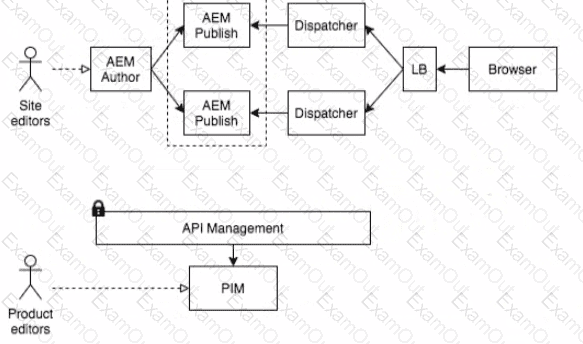In a client's test environment AEM QA Testers from multiple groups and regions are testing and making requests to the AEM application. Due to the sheer number of hosts making connections, an Architect needs a quick and easy way to allow any hosts to make requests to the AEM application.
Which approach should the Architect take to meet this requirement for this non-production environment?
A website built on AEM Sites displays the company's stock price in the footer of all pages. The stock data is retrieved from a third party REST service using two-way SSL and rendered in an AEM component using HTL During performance testing in the last development sprint it becomes apparent that the third party service sometimes takes up to 30 seconds to respond, which degrades the overall site performance.
How should an Architect address this issue?
A client migrated from their On-prem AEM instances to AEMaaCS. One of their requirements is the ability to publish full microsites, including all the children pages. In the legacy implementation, the client used the Tree Activation option in the Classic UI. They want to be able to use the same functionality on AEMaaCS. What is the recommended approach to do this?
An AEM Architect is moving existing content from an on-premise AEM to an AEM Cloud Service instance using the Content Transfer Tool. As part of the initial source preparation, the Architect is going to run the offline compaction on the on-premise AEM.
What other two actions should the Architect do to the on-premise AEM before proceeding with the extraction phase? (Choose two.)
An existing AEM sites platform will receive the latest service pack. The service pack includes functional and non-functional fixes such as security patches. Which action should the Architect take to make sure the update is successful?
On the release day, an AEM code deployment is done on AEM 6.5 on-prem. After the deployment was completed, the users were able to get into the Author instance with no issues. However, users are unable to access any of the sites on public domains. The users are seeing a "502 Bad Gateway" error.
What would be the potential cause of this issue?
After building an AEMaaCS website, it was found that non-cached secured static content will put too much load on the servers. How can this secured static content be cached without creating a security concern?
Refer to the exhibit.

A customer with an existing AEM implementation wants to enrich product pages with technical data coming from their PIM system. The PIM system sits behind an API Management solution that publicly exposes the PIM API's as RESTful web services with basic authentication as the security mechanism. Data consistency with the PIM and secure access to the APIs are key elements of the integration.
How should the Architect set up the integration between AEM and the PIM?
A renowned eCommerce company's flagship product page witnesses a dramatic surge in traffic during the holiday seasons. Over the past few sales events, users have highlighted slower load times and sporadic outages. Preliminary analysis suggests that the current setup might be straining under the increased traffic. The company has recently integrated a Content Delivery Network (CDN) and plans to fine-tune the dispatcher settings. The leadership emphasizes ensuring a seamless user experience for the forthcoming holiday season and wants to leverage the CDN and dispatcher optimally.
Given the situation described, which two approaches should be prioritized to bolster the performance and resilience of the product page during peak traffic? (Choose two.)
A client wants to change how they publish their content. Refer to the following client business requirements:
• The client has a seasonal business that has significant content changes across their site that need to be rolled out at once based on the season change over date.
• The content authors need to be able to work one season in advance of publish dates to ensure that all changes can be completed on time.
• The content authors need a way to indicate that all the seasonal changes are ready. If the content changes are not completed, then the pages should not get published.
• The content authors need the ability to modify the current live pages without rolling back changes for a future content rollout.
What approach should the Architect recommend?

